Introduction
In the fast-paced world of news consumption efficiency matters. Imagine having a secret code that grants you instant access to the most relevant articles in the New York Times (NYT). Well that’s precisely what the four digits to memorize system offers. In this article we’ll delve into how these seemingly innocuous numbers can revolutionize your reading experience.
The Four Digits to Memorize NYT System
The NYT’s four-digit system is a straightforward yet effective way to navigate the print edition:
Section: The first digit indicates the section of the newspaper.
Page Number: The second and third digits represent the page number.
Column Number: The last digit indicates the article number on that page.
Letters after the four digits to memorize NYT denote a continuation on another page. Let’s break it down further:
Section: The first digit signifies the section. For instance:
“A” for front-page news
“B” for business and finance
“C” for arts and culture
“D” for sports
Page Number: The second and third digits tell you which page to turn to. If you see “A12” flip to page 12 in the front section.
Article Number: The last digit points you to the specific article on that page. It’s like having a personal guide to the newspaper’s content.
Tips for Memorizing the Digits
Focus on One Digit at a Time: Avoid overwhelm by concentrating on memorizing one digit at a time.
Create a Story or Image: Leverage your brain’s affinity for stories and visuals. Associate the digits with memorable images or scenarios.
Repeat and Review: Repetition is key to memorization. Regularly review the digits until they become second nature.
Associate with Familiar Dates or Addresses: Link the digits to familiar dates or addresses to add meaning.
Use Mnemonics: Create mnemonic phrases or acronyms to remember the sequence.
The four-digit system appears in various contexts and here are some real-life examples:
Train Ticket Numbers: When you purchase a train ticket the ticket number often consists of four digits. These digits help identify your specific journey and seat assignment.
ATM PIN Codes: Your ATM (Automated Teller Machine) personal identification number (PIN) typically consists of four digits. These numbers ensure secure access to your bank account.
Digital Clocks: Many digital clocks display the time using four digits (e.g., 12:34). The first two digits represent the hour and the last two represent the minutes.
License Plate Numbers: In some regions license plates on vehicles use four digits to memorize NYT. These numbers help identify the vehicle and its registration details.
Room Numbers: In hotels offices or other buildings room numbers often consist of four digits to memorize NYT. They guide visitors to specific locations within the building.
Security Codes: Some security systems such as building access codes or alarm systems use four-digit combinations for entry.
Remember these examples demonstrate how the four-digit system simplifies identification and organization in our daily lives. Whether it’s a train ticket or an ATM PIN those four digits play a crucial role!
FAQs
Why are these digits important?
They streamline your newspaper reading experience allowing you to quickly find relevant articles.
What if I forget the sequence?
Don’t worry! Practice makes perfect. Keep using the system and it will become automatic.
Can I use this for digital editions?
Unfortunately the four-digit system is specific to the print edition. However you can still apply the principles to digital navigation.
Are there exceptions?
Yes, occasionally articles may not follow the standard format. Adaptability is key.
How can I impress my friends with this knowledge?
Next time you’re discussing the news casually drop a reference to the four digits. You’ll be the NYT guru!
Conclusion
So, the next time you pick up a copy of the New York Times remember those four digits to memorize NYT. They’re more than just numbers they’re your gateway to effortless access and informed reading. Now, dear reader what other hidden gems await discovery?






